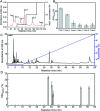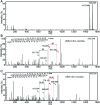Isolation and identification of an antioxidant collagen peptide from skipjack tuna (Katsuwonus pelamis) bone
- PMID: 35528566
- PMCID: PMC9070664
- DOI: 10.1039/c9ra04665h
Isolation and identification of an antioxidant collagen peptide from skipjack tuna (Katsuwonus pelamis) bone
Abstract
To date, many researchers have developed active components that are derived from seafood processing for the purposes of healthcare. Here, an antioxidant collagen peptide was obtained from skipjack tuna (Katsuwonus pelamis) bone by using a combination of trypsin and chymotrypsin as the catalyst. The amino acid sequence of the peptide was identified as Ser-Ser-Gly-Pro-Pro-Val-Pro-Gly-Pro-Met-Gly-Pro-Met-Gly-Pro-Arg (SSGPPVPGPMGPMGPR) by liquid chromatography-electrospray ionization quadrupole time-of-flight mass spectrometry (LC-ESI-QTOF-MS) analysis. We found that the as-prepared collagen peptide can efficiently scavenge DPPH radical (IC50 3.149 mM), superoxide anion radical (IC50 3.803 mM) and ABTS radical (IC50 9.489 mM). In addition, it has been found that the methionine (Met) residue in the collagen peptide could provide a precise active site during the scavenging of DPPH radicals by Fourier transform infrared spectroscopy (FTIR) analysis and matrix-assisted laser desorption/ionization time-of-flight (MALDI-TOF) mass spectrometry analysis. These results suggest that the peptide can find wide uses in the food, cosmetic and pharmaceutical industries.
This journal is © The Royal Society of Chemistry.
Conflict of interest statement
There are no conflicts to declare.
Figures






Similar articles
-
Gelatin and Antioxidant Peptides from Gelatin Hydrolysate of Skipjack Tuna (Katsuwonus pelamis) Scales: Preparation, Identification and Activity Evaluation.Mar Drugs. 2019 Oct 3;17(10):565. doi: 10.3390/md17100565. Mar Drugs. 2019. PMID: 31623339 Free PMC article.
-
Identification and Active Evaluation of Antioxidant Peptides from Protein Hydrolysates of Skipjack Tuna (Katsuwonus pelamis) Head.Antioxidants (Basel). 2019 Aug 19;8(8):318. doi: 10.3390/antiox8080318. Antioxidants (Basel). 2019. PMID: 31430875 Free PMC article.
-
Preparation and Characterization of Gelatin and Antioxidant Peptides from Gelatin Hydrolysate of Skipjack Tuna (Katsuwonus pelamis) Bone Stimulated by in vitro Gastrointestinal Digestion.Mar Drugs. 2019 Jan 24;17(2):78. doi: 10.3390/md17020078. Mar Drugs. 2019. PMID: 30678362 Free PMC article.
-
Screening of synthetic PDE-5 inhibitors and their analogues as adulterants: analytical techniques and challenges.J Pharm Biomed Anal. 2014 Jan;87:176-90. doi: 10.1016/j.jpba.2013.04.037. Epub 2013 May 6. J Pharm Biomed Anal. 2014. PMID: 23721687 Review.
-
Forced degradation and impurity profiling: recent trends in analytical perspectives.J Pharm Biomed Anal. 2013 Dec;86:11-35. doi: 10.1016/j.jpba.2013.07.013. Epub 2013 Jul 31. J Pharm Biomed Anal. 2013. PMID: 23969330 Review.
Cited by
-
Discovering active sites in peptide Ala-Val-Thr-Phe that counter 2,2-azobis(2-methylpropanimidamidine)dihydrochloride-induced oxidative stress in HepG2 cells.RSC Adv. 2020 Jun 26;10(41):24444-24453. doi: 10.1039/d0ra02292f. eCollection 2020 Jun 24. RSC Adv. 2020. PMID: 35516203 Free PMC article.
-
Immunomodulatory, Anticancer, and Antioxidative Activities of Bioactive Peptide Fractions from Enzymatically Hydrolyzed White Jellyfish (Lobonema smithii).Foods. 2024 Oct 22;13(21):3350. doi: 10.3390/foods13213350. Foods. 2024. PMID: 39517134 Free PMC article.
-
Phytochemical Profiling and Antioxidant Activities of the Most Favored Ready-to-Use Thai Curries, Pad-Ka-Proa (Spicy Basil Leaves) and Massaman.Foods. 2024 Feb 14;13(4):582. doi: 10.3390/foods13040582. Foods. 2024. PMID: 38397559 Free PMC article.
-
Marine Antioxidants from Marine Collagen and Collagen Peptides with Nutraceuticals Applications: A Review.Antioxidants (Basel). 2024 Jul 29;13(8):919. doi: 10.3390/antiox13080919. Antioxidants (Basel). 2024. PMID: 39199165 Free PMC article. Review.
-
Bioactive Peptides from Skipjack Tuna Cardiac Arterial Bulbs (II): Protective Function on UVB-Irradiated HaCaT Cells through Antioxidant and Anti-Apoptotic Mechanisms.Mar Drugs. 2023 Feb 1;21(2):105. doi: 10.3390/md21020105. Mar Drugs. 2023. PMID: 36827146 Free PMC article.
References
LinkOut - more resources
Full Text Sources
Other Literature Sources
Miscellaneous

